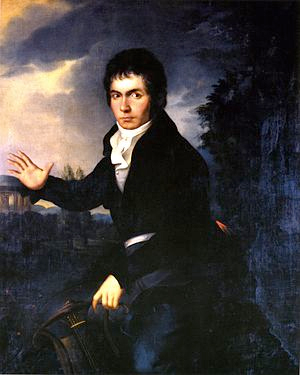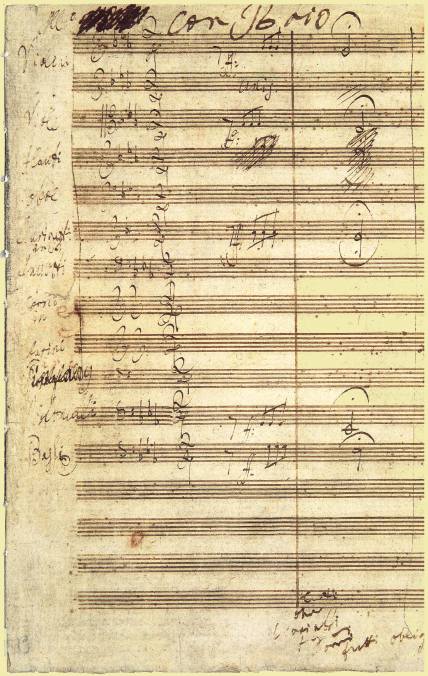
Part of McCalmont’s List Series
Genre: Symphony – a composition for orchestra, usually in several movements
Scoring: Orchestra
Era: Classical – Early Romantic
Length: c. 35 minutes
Will you recognize it? I’d be upset if you didn’t
Recommended Recordings: Carlos Kleiber and the Vienna Philharmonic; or George Szell and the Cleveland Orchestra; or Otto Klemperer and the Philharmonia Orchestra; or Herbert von Karajan and the Berlin Philharmonic (it’s an important piece, okay?)
Composer: Ludwig van Beethoven (1770-1827). What possibly could be said about Beethoven that hasn’t been said already? The composer’s father (a notorious and rowdy drunk) trained Ludwig as a pianist, expecting him to be the next child prodigy like Mozart. Due to his father’s lack of teaching ability, however, Beethoven moved on to other mentors such as Joseph Haydn.
From around the age of 30, Beethoven began to go deaf, and it was around this time he also began to help break down the patronage system, which had dominated the music industry for centuries. He insisted upon writing only the music he wanted to write, not what his patrons requested. Eventually forced to relinquish his virtuoso career as a pianist because of hearing loss, Beethoven continued to pioneer new musical ground in his compositions.
He redefined the symphony, in addition to the string quartet and piano sonata, and his influence on music is still felt today. Sadly, perhaps the biggest name in music history couldn’t even hear his most revolutionary work, the famous Ninth Symphony, when it was performed. Despite this, his works continue to help define drama and universality in music.
The Piece: The symphony was premiered during the same four-hour concert as his Sixth Symphony, Fourth Piano Concerto and Choral Fantasy. Talk about a big night in music history! After shocking musical society with his lengthy Third Symphony, Beethoven stayed within shorter classical lengths for his Fifth, the most revolutionary aspects of the work coming from elsewhere. It is the first piece in the repertoire that utilizes both the piccolo and the trombone. Beethoven also removes the typical pause between the third and fourth movements and has them played attacca (without pause). Perhaps most radically, he unifies the symphony with the famous “short-short-short-long” rhythmic motif. The work also has important philosophical notions, featuring a “darkness to light” narrative, moving from despair in the first movement to triumph in the last. It is rich with dramatic tension and deeply human emotions.

The charming second movement is a theme with variations. Wander along with the variations to see where Beethoven takes the theme. In the third movement, the work returns to a darker location, with sneaky string sections and brooding bassoons. After a bit, the horns howl the first movement’s opening rhythm, relentlessly pursuing the listener and providing no rest. But, after a prolonged and mysterious tension, the fourth movement bursts through gloriously. It is a ten-minute fanfare from the heavens, declaring the struggle over and the journey worthwhile. The coda is perhaps the most triumphant C-Major bash ever to have been conceived.
Personal Notes: Get lost in this symphony. It is one of humanity’s greatest works of art, and speaks to struggles every one of us faces. Find your way to listen to it and enjoy.
Fun Facts:
- One anecdote recalls that during the first rehearsal of the symphony, some orchestra members could not stop laughing because they thought the opening theme was too silly. Their mistake.
- This symphony has made it into so many different pieces of music, never mind media, it would be impossible to make a comprehensive list. A particular favorite was Walter Murphy’s disco version A Fifth of Beethoven.
- Beethoven was aware of his immense musical talent and has been quoted saying, “There are over a thousand counts and dukes. There is only one Beethoven.”
- The opening rhythm is coincidentally the letter “V” in Morse code, and during World War II the symphony was called the “Victory Symphony.”
Further Listening:
- “The Trout” Quintet by Schubert
- Piano Concerto No. 21 by Mozart
- Symphony No. 1 by Gustav Mahler
- PDQ Bach’s “New Horizons in Music Appreciation”
Published on ClevelandClassical.com July 12, 2016.
Click here for a printable copy of this article



